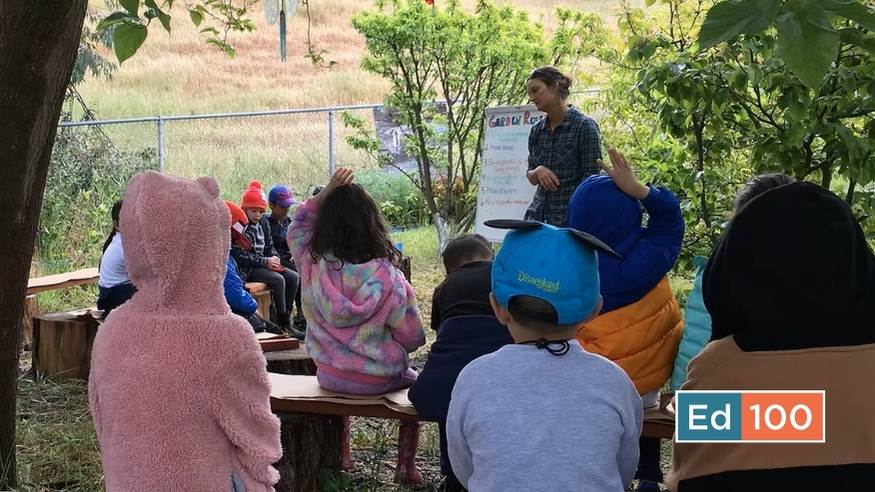School gardens

School gardens: old as dirt.
There's a lot to learn when you get your hands dirty. Since 1970, Earth Day has served as a moment for schools to focus on the lessons we can learn from nature. For schools with gardens, April 22 can serve as a moment for students to step outside with educators and into the context of a living classroom.
According to the United States Department of Agriculture, America’s first school garden was established in 1891 at the George Putnam School in Massachusetts. School gardens became common during and after World Wars I and II when war gardens — and later, Victory Gardens — supplied food that aided indirectly in America’s war effort.
Why gardens?
There doesn’t seem to be anything that gardens can’t do for children, and bushels of research from local, state and federal overwhelmingly support the value of school gardens.
- The National Career Development Agency touts career development.
- The National Library of Health lists studies that link school gardens to increased fruit and vegetable consumption.
- The American Psychological Association even correlates school garden programs to the development of systems thinking skills.
What made school gardens grow?
Many school gardens in California date back to 1995, when then-Superintendent of Public Instruction Delaine Eastin made outdoor education a priority. A statewide program called “A Garden in Every School” promoted nutrition education, healthy eating, biological science and more. California has about 10,000 schools; during her term she celebrated the establishment of more than 3,000 school gardens. The educational aspects of school gardens weren't even the first things on Eastin's mind when she initially called for them.
"I knew educators would respond because I had witnessed the transformation that occurs with students and teachers as they worked in their gardens," she said. "What I did not know was how relevant gardens would become to the educational and nutritional challenges that have since emerged."
Gardens need ongoing attention to flourish, and so do the programs that make school gardens possible. In 2016, a document from the USDA placed the number of school gardens in the whole of the United States at about 7,000 out of the nation’s ~100,000 schools — which seems either impossibly tiny, terribly depressing, or both. Perhaps the likeliest answer is that most school gardens were simply uncounted.
How does a school garden grow? A useful 2022 guide from the Los Angeles School District encourages site administrators to take the lead. School districts have the power to require a garden or space dedicated to outdoor learning in an education specification, which is a document that outlines the facilities needed to support the educational program.
Gathering greenbacks
Like most things that schools need, there is no dedicated funding stream for school gardens. Districts have to find the space and the money — and we know it doesn’t grow on trees!
Districts reap funds from many different sources to put together a comprehensive program. In some districts, the gardens themselves — that is, the fenced planting areas — originate as a small element of a local bond fund for buildings or recreational areas. Planting boxes, gardening tools and supplies, seeds, and plants might come from many sources, such as a school district’s general fund, grant funds, school site budgets or the PTA. The school nutrition program can pay for some expenses related to school gardens and farm-to-school programs, but the program requirements are complex.
Berkeley Public Schools developed a comprehensive program over many years, partly inspired by the well-known restaurateur, chef and cookbook writer Alice Waters, who lives nearby. The program is supported through a combination of workforce development funds, health department grants, funds from the school district’s general fund, after school funds and a variety of state and local grant opportunities. Enjoy a little Earth Day inspiration:
The role of community-building organizations
Many organizations provide services to schools to help their garden programs in various ways, including planning and educational design. Examples include Lifelab, Growing Together and School Garden Network. They might provide technical skills to help establish gardens, connect schools with garden educators, and offer professional development and curriculum support related to environmental literacy, plant biology, climate science, and more.
Curriculum options
Schools and school districts may develop or purchase garden curriculums for their students. Berkeley Public Schools has a well-established and highly regarded Garden and Cooking program and a curriculum aligned with the Common Core State Standards and Next Generation Science Standards.
A seed of an idea? Possible legislation
California education law has long included a section about School Instructional Gardens. Unfunded, this law has been essentially dormant for many years. In 2025, a bipartisan group of California state senators co-authored a bill (SB 341, Pérez, Ochoa Bogh, and Rubio) with the aim of restoring and revitalizing the program under administration of the Department of Food and Agriculture.
To be clear, there’s no dedicated funding for school gardens proposed in this bill. But it opens a new channel through which future funding could flow to restore the program. It's a clever approach to try formally involving talented folks in education and agriculture together. As of this writing, a hearing for the bill is scheduled for the morning of April 29, 2025 in the Senate Agriculture committee. With luck, this effort could help gardens take root in more schools.
What’s your school garden story? We’d like to know.
Tags on this post
Facilities HealthAll Tags
A-G requirements Absences Accountability Accreditation Achievement gap Administrators After school Algebra API Arts Assessment At-risk students Attendance Beacon links Bilingual education Bonds Brain Brown Act Budgets Bullying Burbank Business Career Carol Dweck Categorical funds Catholic schools Certification CHAMP Change Character Education Chart Charter schools Civics Class size CMOs Collective bargaining College Common core Community schools Contest Continuous Improvement Cost of education Counselors Creativity Crossword CSBA CTA Dashboard Data Dialogue District boundaries Districts Diversity Drawing DREAM Act Dyslexia EACH Early childhood Economic growth EdPrezi EdSource EdTech Education foundations Effort Election English learners Equity ESSA Ethnic studies Ethnic studies Evaluation rubric Expanded Learning Facilities Fake News Federal Federal policy Funding Gifted Graduation rates Grit Health Help Wanted History Home schools Homeless students Homework Hours of opportunity Humanities Independence Day Indignation Infrastructure Initiatives International Jargon Khan Academy Kindergarten LCAP LCFF Leaderboard Leadership Learning Litigation Lobbyists Local control Local funding Local governance Lottery Magnet schools Map Math Media Mental Health Mindfulness Mindset Myth Myths NAEP National comparisons NCLB Nutrition Pandemic Parcel taxes Parent Engagement Parent Leader Guide Parents peanut butter Pedagogy Pensions personalized Philanthropy PISA Planning Policy Politics population Poverty Preschool Prezi Private schools Prize Project-based learning Prop 13 Prop 98 Property taxes PTA Purpose of education puzzle Quality Race Rating Schools Reading Recruiting teachers Reform Religious education Religious schools Research Retaining teachers Rigor School board School choice School Climate School Closures Science Serrano vs Priest Sex Ed Site Map Sleep Social-emotional learning Song Special ed Spending SPSA Standards Strike STRS Student motivation Student voice Success Suicide Summer Superintendent Suspensions Talent Teacher pay Teacher shortage Teachers Technology Technology in education Template Test scores Tests Time in school Time on task Trump Undocumented Unions Universal education Vaccination Values Vaping Video Volunteering Volunteers Vote Vouchers Winners Year in ReviewSharing is caring!
Password Reset
Search all lesson and blog content here.
Login with Email
We will send your Login Link to your email
address. Click on the link and you will be
logged into Ed100. No more passwords to
remember!





 Explained by
Explained by








Questions & Comments
To comment or reply, please sign in .